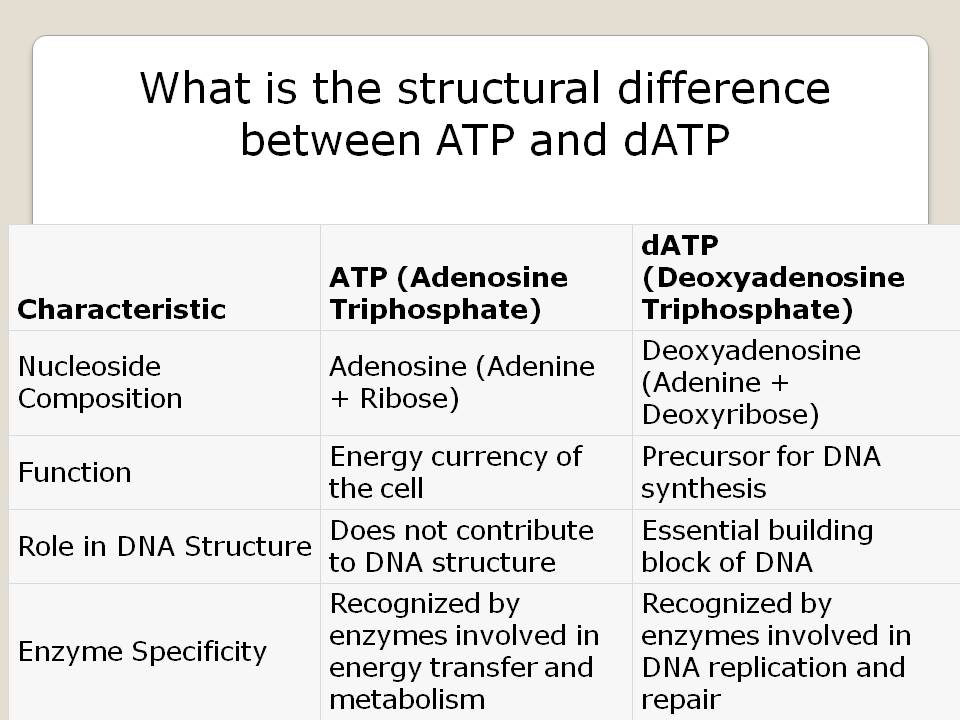Adenosine triphosphate (ATP) and deoxyadenosine triphosphate (dATP) are two crucial molecules in biology, serving as the primary carriers of chemical energy and components for DNA synthesis, respectively.
While they share some structural similarities, there are key differences that make them unique in their respective roles.
Here we will explore the structural differences between ATP and dATP.
- Nucleoside Composition
The primary structural difference between ATP and dATP lies in their nucleoside composition. Both molecules start with an adenosine base, which consists of adenine and ribose sugar. However, the key distinction arises in the type of sugar present.
In ATP, the sugar is ribose, while in dATP, it is deoxyribose. Deoxyribose lacks an oxygen atom at the 2′ position, giving rise to the “deoxy” prefix in its name. This subtle alteration is critical in defining their respective roles in cellular processes.
- Function
ATP is often referred to as the “energy currency of the cell.” Its primary role is to store and transfer energy within cells. The three phosphate groups in ATP are crucial for this function. When one or two phosphate groups are cleaved, energy is released, providing the necessary energy for various cellular processes, such as muscle contraction, active transport, and biosynthesis.
In contrast, dATP is a precursor molecule for DNA synthesis. It plays a vital role in the replication and repair of DNA. DNA is composed of four nucleotides, one of which is dATP. During DNA replication, dATP is incorporated into the growing DNA strand by DNA polymerase enzymes, forming the adenine base pairs necessary for accurate duplication of genetic information.
- Role in DNA Structure
Another structural difference between ATP and dATP lies in their role in DNA structure. ATP does not directly contribute to the structure of the DNA molecule, whereas dATP is an essential building block of DNA.
When dATP is incorporated into the DNA strand, it pairs with thymidine (T), forming A-T base pairs, which are complementary to the G-C base pairs formed by guanine (G) and cytosine (C). This base-pairing ensures the precise and complementary nature of DNA strands, which is essential for genetic stability and accurate information transfer during replication.
- Enzyme Specificity
Enzymes play a crucial role in the utilization of both ATP and dATP. Enzymes that interact with ATP are generally involved in processes related to energy transfer and cellular metabolism. These enzymes recognize the ribose sugar in ATP and its three phosphate groups.
While, enzymes involved in DNA synthesis, such as DNA polymerases, specifically recognize dATP due to the deoxyribose sugar present in its structure. This enzyme specificity ensures that dATP is used exclusively for DNA synthesis and not for energy production.
ATP is the main energy carrier in cells, powering various processes.
DATP is a building block for DNA synthesis, used during DNA replication. The key difference is that ATP is for energy, while DATP is for DNA formation.
Yes, DATP is energy-poor compared to ATP. Its main role is in DNA synthesis, not energy transfer like ATP.
DATP (deoxyadenosine triphosphate) consists of three parts: adenine (a nitrogenous base), deoxyribose (a sugar without an oxygen at the 2′ position), and three phosphate groups.
